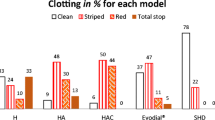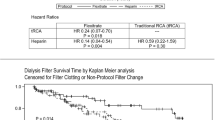Abstract
Background
To date, no study has investigated the use of vitamin K antagonists (VKA) in children undergoing chronic haemodialysis (HD) with a central venous catheter (CVC).
Methods
Consecutive patients aged <18 years with a newly placed tunnelled CVC for chronic HD were enrolled over a 3-year period. Children with active nephrotic syndrome or a history of venous thrombosis received warfarin (VKA group) with therapeutic target international normalised ratios of between 2.0 and 3.0. Patients at standard risk of CVC malfunction were not treated with VKA (standard group). The primary end-point was overall CVC survival.
Results
The VKA group consisted of nine patients (median age 10.6 years; range 1.2–15.3 years) with 11 CVC, and the standard group comprised eight patients (11.8 years; 6.1–17.3 years) with ten CVC. The 6- and 12-month CVC survival was significantly longer in the VKA group than in the standard group (100 vs. 60 % and 83.3 vs. 16.7 %, respectively; p < 0.05), with a median survival of 369 and 195 days, respectively (p < 0.05). None of the CVC in the VKA group required removal due to malfunction, as compared to four in the standard group. No major bleeding episodes occurred in either group.
Conclusions
Therapy with VKA would appear to be safe in children on chronic HD and may improve CVC survival in patients at increased risk of CVC thrombosis.


Similar content being viewed by others
References
Chand DH, Valentini RP, Kamil ES (2009) Hemodialysis vascular access options in pediatrics: considerations for patients and practitioners. Pediatr Nephrol 24:1121–1128
Ramage IJ, Bailie A, Tyerman KS, McColl JH, Pollard SG, Fitzpatrick MM (2005) Vascular access survival in children and young adults receiving long-term hemodialysis. Am J Kidney Dis 45:708–714
Chand DH, Brier M, Strife CF (2005) Comparison of vascular access type in pediatric hemodialysis patients with respect to urea clearance, anemia management, and serum albumin concentration. Am J Kidney Dis 45:303–308
Zaritsky JJ, Salusky IB, Gales B, Ramos G, Atkinson J, Allsteadt A, Brandt ML, Goldstein SL (2008) Vascular access complications in long-term pediatric hemodialysis patients. Pediatr Nephrol 23:2061–2065
Paglialonga F, Rossetti G, Giannini A, Chidini G, Napolitano L, Testa S, Meregalli E, Biasuzzi A, Edefonti A (2012) Split catheters in children on chronic hemodialysis: a single-center experience. Hemodial Int 16:394–400
National Kidney Foundation (NKF) (2006) KDOQI clinical practice guidelines and clinical practice recommendations for 2006 updates: hemodialysis adequacy, peritoneal dialysis adequacy, vascular access. Am J Kidney Dis 48[Suppl 1]:S1–S322
Chand DH, Valentini RP (2008) International pediatric fistula first initiative: a call to action. Am J Kidney Dis 51:1016–1024
Fadrowski JJ, Hwang W, Neu AM, Fivush BA, Furth SL (2009) Patterns of use of vascular catheters for hemodialysis in children in the United States. Am J Kidney Dis 53:91–98
Valentini RP, Geary DF, Chand DH (2008) Central venous lines for chronic hemodialysis: survey of the Midwest pediatric nephrology consortium. Pediatr Nephrol 23:291–295
Neu AM, Ho PL, McDonald RA, Warady BA (2002) Chronic dialysis in children and adolescents. The 2001 NAPRTCS annual report. Pediatr Nephrol 17:656–663
Leonard MB, Donaldson LA, Ho M, Geary DF (2003) A prospective cohort study of incident maintenance dialysis in children: an NAPRTCS study. Kidney Int 63:744–755
Neu AM, Fivush BA, Warady BA, Watkins SL, Friedman AL, Brem AS, Goldstein S, Frankenfield DL (2003) Longitudinal analysis of intermediate outcomes in adolescent hemodialysis patients. Pediatr Nephrol 18:1172–1176
Hayes WN, Watson AR, Callaghan N, Wright E, Stefanidis CJ, the European Pediatric Dialysis Working Group (2012) Vascular access: choice and complications in European paediatric haemodialysis units. Pediatr Nephrol 27:999–1004
Wang AY, Ivany JN, Perkovich V, Gallagher MP, Jardine MJ (2013) Anticoagulant therapies for the prevention of intravascular catheters malfunction in patients undergoing haemodialysis: systematic review and meta-analysis of randomized, controlled trials. Nephrol Dial Transplant 28:2875–2888
Mokrzycki MH, Jean-Jerome K, Rush H, Zdunek MP, Rosenberg SO (2001) A randomized trial of minidose warfarin for the prevention of late malfunction in tunneled, cuffed hemodialysis catheters. Kidney Int 59:1935–1942
Traynor JP, Walbaum D, Woo YM, Teenan P, Fox JG, Mactier RA (2001) Low-dose warfarin fails to prolong survival of dual lumen venous dialysis catheters. Nephrol Dial Transplant 16:645
Wilkieson TJ, Ingram AJ, Crowther MA, Soroka SD, Nagai R, Jindal KK, Clase CM (2011) Low-intensity adjusted-dose warfarin for the prevention of hemodialysis catheter failure: a randomized, controlled trial. Clin J Am Soc Nephrol 6:1018–1024
Abdul-Rahman IS, Al-Howaish AK (2007) Warfarin versus aspirin in preventing tunneled hemodialysis catheter thrombosis: a prospective randomized study. Hong Kong J Nephrol 9:23–30
Coli L, Donati G, Cianciolo G, Raimondi C, Comai G, Panicali L, Nastasi V, Cannarile DC, Gozzetti F, Piccari M, Stefoni S (2006) Anticoagulation therapy for the prevention of hemodialysis tunneled cuffed catheters (TCC) thrombosis. J Vasc Access 7:118–122
Christiansen CF, Schmidt M, Lamberg AL, Horváth-Puhó E, Baron JA, Jespersen B, Sørensen HT (2014) Kidney disease and risk of venous thromboembolism: a nationwide population-based case–control study. J Thromb Haemost 12:1449–1454
Tavil B, Kara F, Topaloglu R, Aytac S, Unal S, Kuskonmaz B, Cetin M, Besbas N, Gumruk F (2015) Case series of thromboembolic complications in childhood nephrotic syndrome: Hacettepe experience. Clin Exp Nephrol 19:506–513
Singhal R, Brimble KS (2006) Thromboembolic complications in the nephrotic syndrome: pathophysiology and clinical management. Thromb Res 118:397–407
Glassock RJ (2007) Prophylactic anticoagulation in nephrotic syndrome: a clinical conundrum. J Am Soc Nephrol 18:2221–2225
Suri D, Ahluwalia J, Saxena AK, Sodhi KS, Singh P, Mittal BR, Das R, Rawat A, Singh S (2014) Thromboembolic complications in childhood nephrotic syndrome: a clinical profile. Clin Exp Nephrol 18:803–881
Barbano B, Gigante A, Amoroso A, Cianci R (2013) Thrombosis in nephrotic syndrome. Semin Thromb Hemost 39:469–476
Pincus KJ, Hynicka LM (2013) Prophylaxis of thromboembolic events in patients with nephrotic syndrome. Ann Pharmacother 47:725–734
Kerlin BA, Ayoob R, Smoyer WE (2012) Epidemiology and pathophysiology of nephrotic syndrome-associated thromboembolic disease. Clin J Am Soc Nephrol 7:513–520
Wright JM, Watts RG (2011) Venous thromboembolism in pediatric patients: epidemiologic data from a pediatric tertiary care center in Alabama. J Pediatr Hematol Oncol 33:261–264
MacRae JM, Ahmed A, Johnson N, Levin A, Kiaii M (2005) Central vein stenosis: a common problem in patients on hemodialysis. ASAIO J 51:77–81
Schulman S, Kearon C, Subcommittee on Control of Anticoagulation of the Scientific and Standardization Committee of the International Society on Thrombosis and Haemostasis (2005) Definition of major bleeding in clinical investigations of antihemostatic medicinal products in non-surgical patients. J Thromb Haemost 3:692–694
Kovalski Y, Cleper R, Krause I, Davidovits M (2007) Hemodialysis in children weighing less than 15 kg: a single center experience. Pediatr Nephrol 22:2105–2110
Schillinger F, Schillinger D, Montagnac R, Milcent T (1991) Post catheterization vein stenosis in haemodialysis: comparative angiographic study of 50 subclavian and 50 internal jugular accesses. Nephrol Dial Transplant 6:722–724
Hernández D, Díaz F, Rufino M, Lorenzo V, Pérez T, Rodríguez A, De Bonis E, Losada M, González-Posada JM, Torres A (1998) Subclavian vascular access stenosis in dialysis patients: natural history and risk factors. J Am Soc Nephrol 9:1507–1510
Yevzlin AS (2008) Hemodialysis catheter-associated central venous stenosis. Semin Dial 21:522–527
Goldstein SL, Macierowski CT, Jabs K (1997) Hemodialysis catheter survival and complications in children and adolescents. Pediatr Nephrol 11:74–77
Sheth RD, Kale AS, Brewer ED, Brandt ML, Nuchtern JG, Goldstein SL (2001) Successful use of Tesio catheters in pediatric patients receiving chronic hemodialysis. Am J Kidney Dis 38:553–559
Eisenstein I, Tarabeih M, Magen D, Pollack S, Kassis I, Ofer A, Engel A, Zelikovic I (2011) Low infection rates and prolonged survival times of hemodialysis catheters in infants and children. Clin J Am Soc Nephrol 6:793–798
Silverstein DM, Moylan K (2010) Cause and outcome of central venous catheter infections in paediatric haemodialysis patients. Nephrol Dial Transplant 25:3332–3337
Yee DL, O'Brien SH, Young G (2013) Pharmacokinetics and pharmacodynamics of anticoagulants in paediatric patients. Clin Pharmacokinet 52:967–980
Author information
Authors and Affiliations
Corresponding author
Ethics declarations
Ethics statement
The study was approved by the local Ethical Committee and conforms with the Declaration of Helsinki. All parents gave written informed consent
Conflict of interest
The authors declare no conflict of interest.
Rights and permissions
About this article
Cite this article
Paglialonga, F., Artoni, A., Braham, S. et al. Vitamin K antagonists in children with central venous catheter on chronic haemodialysis: a pilot study. Pediatr Nephrol 31, 827–832 (2016). https://doi.org/10.1007/s00467-015-3293-1
Received:
Revised:
Accepted:
Published:
Issue Date:
DOI: https://doi.org/10.1007/s00467-015-3293-1




